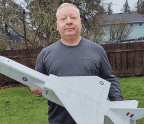STEPHENS AKRO

Editor’s note: This construction article is from the Model Airplane News classic series and it was first published in July 2004 issue of Backyard Flyer. Some of the original hardware may not be available but similar hardware and power systems are available online.
Designed by Clayton Stephens, the full-size Stephens Akro was an aerobatic aircraft that dates back to the late 1960s. One of the first aerobatic pilots to compete with the Akro was Leo Loudenslager. He eventually modified his Akro and developed the now famous Laser. I had always liked the appearance of the Stephens Akro, and it’s been a popular modeling subject for a long time.
Thin foam sheet has been a great building material for years making it easy to build lightweight electric aircraft. Low cost and rapid building time also encourages experimentation with different design ideas because the models can be produced quickly and test flown. From aerobatic aircraft to military fighters, almost anything can be reproduced with this profile foam format.
Today, there’s also a huge choice in powerplants and batteries; low-cost brushed motors give very good performance. If you go for the more expensive brushless motors
You’re reading a preview, subscribe to read more.
Start your free 30 days



